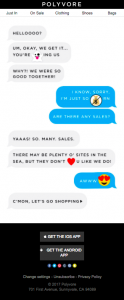Product pages showcase the core of your e-commerce business, but they often get overlooked when it comes to SEO and content marketing. However, with just a few tweaks you can dramatically improve a customer’s experience on your page, drive better lead conversion and ideally end up with more money in your pocket. Let’s go over five simple practices you can implement today to make your product pages rise above your competitors’:
1. Don’t slack. Write product descriptions.
Sounds dull, but we see missing product descriptions in e-commerce stores all the time. Don’t make that mistake. Just as for the rest of your website, user experience should be your main concern here and only pretty images aren’t going to cut it. Get creative with your descriptions, implement long-tail keywords and focus on the product’s benefits rather than only talking about functions. We recommend about 200 – 400 unique words for each product to our clients. “Unique” being the key here as duplicate content will kill your Google ranking.
2. Optimize For Mobile. There’s no way around it.
Our web designers are all about optimizing for mobile. A page that doesn’t offer a great user experience on mobile is a broken page (loosely quoting our designer Iuilia here). And she doesn’t stand alone with that passionate opinion: Google says that not having a mobile optimized website is like closing your store one day each week. Yikes! It was just announced by StatsCounter that last month mobile browsing finally surpassed desktop internet usage on a global level for the first time ever, yet mobile and tablet devices only create 26% of revenue. This may not seem like a huge deal in terms of sales yet, but things are definitely changing. So optimize your pages now before you miss out on paying customers as the scale tips toward mobile shopping. With almost half of the average website traffic, imagine the revenue potential of an amazing mobile product page!

3. Showcase your product like there’s no tomorrow.
Don’t make people search around on your website. Give them everything that might be of interest about your product right where you’ve got them: On your product page.
- Provide colour and size options (And a sizing chart! If I need to go somewhere else to find out what size I need your product in, I might not come back.)
- Make your product shine with high resolution images and videos from every angle, show close-ups of interesting details and offer an easy slider to scroll through all of them. (I can’t stand having to click for every single picture.)
- Include user reviews and ratings. Real ones, please. You could incentivise happy customers with a little discount on their next purchase if they leave a review. Or just ask really nicely. Either way, another bit of useful information that’ll help future customer towards their purchase.
- Show related products to keep them engaged and interested even if they lose interest in their current object of desire. Cross-selling is a smart way to keep your customers excited and active on your page.
4. Meta descriptions and snippets are your friends.
When you’re polishing your product page content, don’t forget a catchy meta description that addresses exactly what would get search engine users interested in your link. Metas don’t directly relate to SEO itself (keep in mind: keyword stuffing does nothing) but your page’s meta description is what people see first when your page shows up on their Google search results, so make it count. Get them curious enough to click!
Including rich snippets can get you a high-five from Google. All you need to is add structured data to your page’s existing HTML, which allow search engines and users to better understand what information is contained on such page. These little extra pieces of information can include customer reviews, availability, price of the product, and so on.
Expert Tip: Lots of themes require you to add review apps (which help conversions) but be sure to check that it includes rich snippets, so your reviews are already marked up – no coding required.


Even though meta descriptions and rich snippets don’t directly affect your rankings, they have the potential to affect it based on on-page behavioral data that is a key part of Google’s algorithm. I’m drifting off into tech talk. Here’s a concrete example: Google wants to be useful to people. Therefore, it is their goal to show only relevant pages as search results. If I search for something on Google, click on a link that showed up and find what I’m looking for right there I’m happy and so is Google. A page that has a high user engagement rate – meaning only very few people land on your site and immediately bounce off because this wasn’t what they were looking for – Google will recognize that and factor it into the “user friendliness’”part of their algorithm. Based on that, your page ranking will ultimately go up and you’ll get even more people to click. It’s a beautiful cycle of SEO success.
Bottom line: So called “rich snippets” can not only earn you a higher CTR (click-through rate) but also a higher Google ranking. So, make sure to pay attention to detail and provide potential customers with useful information right off the bat to give them what they’re looking for.
5. Loading time. Because ain’t nobody got time for that.
“Every 100ms increase in load time decreases sales by 1%.”
Amazon
Tick Tock! Users expect your product page to load as quickly on their mobile phone as it does on their tablet or home computer. But how quick is quick enough? Based on our experience at seoplus+ we recommend under 2 seconds to all of our clients.
“At the end of the day, Google wants to provide the best experience possible to it’s audience. If your site takes longer than 6 seconds to load, users will bounce right away.” says our SEO Specialist Lindsay Kavanagh, “ Google will begin to notice that and demote your site. With more searches happening on mobile (as of 2015) – it has become even more important to have your site load as quickly as possible.”

I personally will browse the web for stuff I’m interested in on the bus on my way home (so I don’t have to absorb unnecessary information about other people’s lives). Now, factor in that I’m an incredibly impatient person and it’s clear that if your product doesn’t load for me before I have to hop off, you’re out of the running. I probably sound like a broken record by now but: User experience, people. User Experience.
Expert Tip: To save yourself the trouble of trying to optimize a slow website theme, scan your favorite themes in GT Metrix before picking one to build your store on. Turbo is a fresh new theme from Out of the Sandbox that provides lazy load and is quick!
You see, there’s a long list of other things you can work on if you want to optimize your page conversions. If you want to know now how to speed up your page load time, perfect your snippets or write a killer product description get in touch with our SEO Specialists for a free evaluation of your site. We’re always happy to chat.
Digital & Social Articles on Business 2 Community(109)
Report Post





